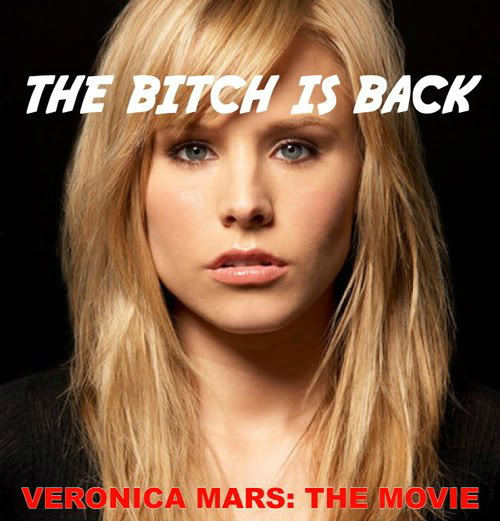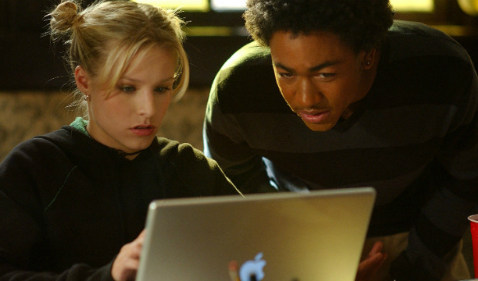Written by Katherine Murray.
In 1995, Waterworld was known for being stupid, stupidly expensive, and the first in a series of bad decisions that hurt Kevin Costner’s career — its reputation hasn’t changed a lot since then. Still, if I’m honest with you, the movie didn’t bother me that much when I was 11. Watching it again this past weekend, I wasn’t exactly shocked to find my perceptions had changed, but I was interested to see where Waterworld falls in the history of popular culture – including popular notions of gender. The movie isn’t as good as you’d hope – in fact, in many ways, it’s really, really bad – but it represents an important phase in how we understood ourselves as men and women.
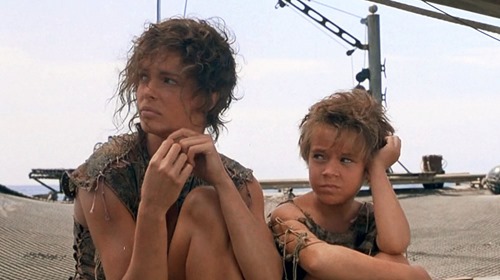
For those of you who’ve blocked it out, Waterworld is a post-apocalyptic action-adventure movie about a future where the polar icecaps have melted, and humanity lives aboard boats, rafts, and makeshift floating cities. Dirt has become a form of currency, and people preserve fresh, drinkable water at all costs. In the midst of this open sea nightmare, Kevin Costner (whose character doesn’t have a name) is a mutant drifter who lives on the margins, salvaging, trading, and doing battle with pirates, all while looking bad-ass on his boat. Jeanne Tripplehorn is Helen, a shopkeeper on one of the floating cities, who’s adopted a girl named Enola – played by a 10-year-old Tina Majorino.
Enola has a map on her back that no one can interpret, which might show the way to dry land. When a group of pirates hears about it, they attack the floating city to kidnap her, and Helen makes a deal with Kevin Costner to save all their lives. The three of them travel together for most of the movie, facing random dangers on the sea, before they finally have a big showdown with the pirates.
From a critical perspective, Waterworld is both not as bad as we remember it, and worse than we remember it – suffering most from an inconsistent tone. The pirates are like something out of a Saturday morning cartoon, and everything that’s not the pirates is much more serious and grim than the movie seems to think it is. Judging Waterworld by the standards of ‘90s action-adventure movies, where were pretty broad in terms of character and plot, the first act is really promising. The plot points fall like dominoes to get Kevin Costner, Helen, and Enola on the ship together – there’s genuine tension, and all three characters are interesting.
From the vantage point of 2015, it would be easy to criticize the movie for its lack of subtlety and formulaic plot, but that’s partly because cinema has changed a lot in 20 years. Waterworld was created at a time when mainstream audiences didn’t expect a lot of self-referential humour or genre-subverting plot twists. Part of the reason we have so much of that now is because we first had a long stretch of films that were simple and earnest, and collectively established the genre conventions in the first place. It’s not that Waterworld’s doing anything so great and interesting – it’s just that, in terms of plot development, it’s more in the middle of the pack for 1995.
It’s also in the middle of the pack in terms of how gender’s portrayed, and that makes it an interesting snapshot of where were just 20 years ago – both in terms of how far Waterworld is from the movies that came out before, and how far it is from the movies coming out now. From the perspective of gender analysis, the most important part of the movie is the slow-moving part in the middle, where the story’s just about three people on a boat, and how they relate to each other.
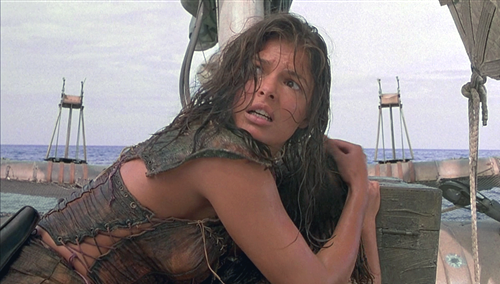
Like many female leads of the ’90s, Helen is required to be capable, but not so capable that the man in her life can’t outdo her. She’s also required to be outspoken, as long as no one has to listen when she talks. In the movie’s first act, Helen breaks Kevin Costner out of a cage when the elders in her village try to murder him for being a mutant outsider. She and Enola see that he’s their opportunity to leave the city, and the three of them work together to open the gates and escape in his boat.
As soon as they’re on the boat, though, the story takes an ugly and confusing turn. Kevin Costner first wants to pitch Enola overboard because she’ll use up his resources and, although he lets both of them stay in the end, he’s completely fucking horrible for over half the movie, and it’s not clear how aware the movie is that that’s the case. The movie doesn’t seem to think it’s right for him to act like such an asshole, but it seems to think that this is understandable behaviour, and, sometimes, that it kind of makes him cool. Among the violent, hateful things Kevin Costner does:
- He actually does throw Enola overboard, though we’re supposed to forgive him because he changes his mind and goes back for her
- He cracks Helen in the head with a paddle, nearly knocking her unconscious, but her body is under a sail so we don’t have to see how brutal it is
- He pimps Helen out to an obviously unbalanced creepball they meet on the sea, over her repeated objections – again, we’re supposed to forgive him because he changes his mind
In one of the most disturbing scenes, Helen damages the ship’s harpoon by using it to fight off pirates (and she manages to screw up fighting pirates so that Kevin Costner can look like the hero). Kevin Costner decides – and the film seems to agree with him – that he has the right to punish her for this by swinging a machete at her head and cutting off her hair. Enola speaks up to tell him he’s being an asshole, at which point he notices that she’s been using his crayons after he told her not to. We cut to shot where we see that Helen and Enola have now both lost their hair, and they sheepishly move out of Kevin Costner’s way when he walks by, and stop talking so they don’t annoy him. The movie doesn’t show us Kevin Costner swinging a machete at a terrified 10-year-old girl, and it seems to want us to think it’s funny that he’s restored order on the boat by getting the women to shut the hell up and stay out of his way.
Helen represents a new kind of fantasy woman, popular in the late ’80s and ’90s – one who’s ballsy and opinionated, but can absolutely, 100 percent, still be controlled. In fact, the only reason Helen’s “safe” for mainstream audiences in 1995 is that Kevin Costner’s total dominance over her is constantly reinforced. First, they butt heads in a series of conflicts he always easily wins, and then, once she starts to fall in love with him, they stop butting heads about anything, and she drops back to follow his lead. The message is basically that, if he can learn to be nicer to her, she can acknowledge that he’s her superior.
Helen is a step up from the days when the ideal woman was silent, empty-headed, and dependent, but she still exists mostly as an artefact of male fantasy. She’s fiery at first, because the man of 1995 could find that sexy. And, even though she stands up to the pirates, she’s ultimately submissive for the right kind of guy, because the man of 1995 found that non-threatening. What we see in Waterworld is a snapshot of American culture’s evolving idea of women, at a stage when we were trying to convince ourselves that feminism was compatible with all of the existing power structures patriarchy built, if we could just find the right way to look at it. We no longer believed that men had the right to control women, ipso facto, no matter what – but we still seemed to believe that men could earn the right to control certain women, by meeting vaguely defined obligations toward them. Because Kevin Costner ultimately protects Helen and Enola from other men, and overcomes his natural urge to murder them himself, he earns the right to be the boss in their relationship. It’s maybe half a step back from where we are now, and one step forward from when we were chattel.
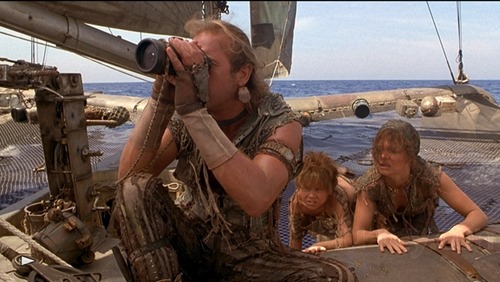
Aside from the predictably horrible stuff about women, Waterworld is also interesting because of the snapshot it gives us of maleness. Kevin Costner’s character is antiquated by today’s standards – a type of hyper-competent manly man we don’t believe exists anymore, outside of adolescent fantasy. He’s good at everything he does, he kills people, he has a cool boat, he’s stoic, he’s wise, he gets the best of anyone who tries to screw him over – he’s such a badass that, when he goes fishing, he lets a sea monster swallow him whole so he can kill it from the inside.
He’s basically a cowboy who drinks his own piss.
At the same time, there’s a sense of vulnerability to character, because he hasn’t chosen to be an outsider. He’s an outcast because he’s a mutant, ashamed of his gills and webbed feet, forced to hide them for fear of being discovered. The movie strongly implies that the reason he’s mean isn’t just because it’s neat to be an asshole, or because he’s privy to some deep truth about the harsh realities of life – it’s partly because he’s lonely and he needs to learn how to connect with other people. In fact, the entire arc of his character development – such as it is – is that he learns to be less selfish, and becomes attached enough to Helen and Enola that he’ll risk his life and lose his boat to save them.
In the narrative of 1995, male leads still need to prove they’re capable of doing all the bad-ass things that men are supposed to be able to do. They still have to show that they don’t want to be all sissified, and caring, and interested in having conversations – they don’t want to hang around with women all the time, they don’t want to talk about their feelings, they don’t want to be all lame and interested in things like friendship when they could just swing machetes at your face – but then, somehow, somewhat against their will, they gradually start to have some vulnerable emotions and, as long as they keep blowing up the pirate ships, it’s still OK.
This doesn’t seem like a big deal by today’s standards, where male leads are often awkward, average, bumbling guys who get by with the help of their friends, but, in terms of action-adventure movie standards, having a hero who expressed self-doubt, loneliness, or insecurity was a step toward acknowledging that men have feelings, too.
The scene in Waterworld that’s maybe most instructive about how the movie sees both men and women, and the dynamics of relationships between them, is the scene just as we enter act two. Kevin Costner says he wants to toss Enola overboard, and Helen offers to have sex with him if she and Enola can stay. There’s a wide shot of the deck as she takes off her dress, and then there’s a long, silent moment where the actors communicate a lot of information through their expressions. It’s clear that Helen doesn’t want to sleep with Kevin Costner – that this is a horrible sacrifice she’s making to keep Enola safe, and it’s basically the worst day of her life. Kevin Costner is, at first, tempted by her offer, because he’s lonely, but, when he reads the disgust in her face, he backs off – maybe because he thinks she’s disgusted by his being a mutant, maybe because he doesn’t want to have sex with someone who isn’t into it, no matter what the reason – we don’t know. When she asks him later why he didn’t do it, his answer is the equally unreadable, “Because you didn’t want me.”
Waterworld is a movie that understands that women don’t actually want to have sex random dudes just because they are the heroes of the movie. It understands that, when women offer to trade sex for something, it’s usually not because they feel great about the deal. It understands that it would be wrong for Kevin Costner to accept the trade. At the same time, it’s a movie that wants to show us Jeanne Tripplehorn’s butt when she takes off her dress, and make sure we know that Kevin Costner totally could have done it with her if he wasn’t such a stand-up guy. Just like to totally could have murdered that kid, and totally could have pimped out his lady friend, also if he wasn’t such a stand-up, awesome guy.
It’s a vision of a world where men can still have the power to do whatever they want to to women, but where they sometimes shouldn’t – where, in fact, they are princely, amazing, good guys if they don’t. It’s a world where you should try to be nice to the people in a one-down position from you, as long as they aren’t climbing up.
Also, it’s a world where any random rope can be a bungee cord, and I don’t understand that part quite as well.
Katherine Murray is a Toronto-based writer who yells about movies and TV on her blog.


